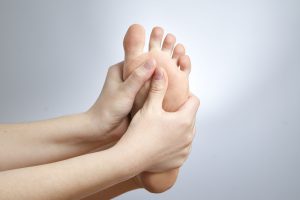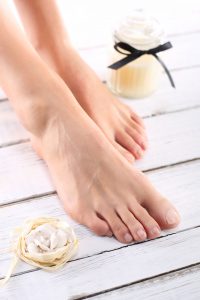Medically Reviewed by Dr. Rachel N. Verville
March 13, 2023

When you live with diabetes, you have a number of everyday concerns that compete for your attention. For example, you need to monitor your blood sugar, make wise dietary decisions, and find time for physical fitness. Given all these demands, it is only natural if footcare feels like a low priority.
And yet, given the prevalence of foot-related complications within the diabetic community, footcare should really be something that warrants more attention. By following a few basic diabetic footcare guidelines, you may be able to prevent diabetes-related foot complications from developing at all.
How to Avoid Diabetic Foot Complications
1) Check Your Feet Every Day
One of the issues that diabetics face is nerve damage in their feet. Nerve damage means your feet might sustain injuries without you feeling any pain. This often means that those injuries are left to fester, rather than getting the prompt treatment they require.
A simple way to minimize foot-related complications is to be diligent about checking your feet each day. Sit down to look them over for any corns, blisters, sores, or other problems with the skin and nails.
Not only can this simple daily practice help you identify potential issues, but it is also a good way to gauge your current level of nerve damage in your feet.
2) Wash Your Feet
Another important daily practice is washing your feet. Do this in water that is warm, but not scalding hot. When you are done, dry your feet thoroughly and apply lotion to the tops of them. (You can combine our first and second tips by checking as you wash to save some time.)
A couple of things to avoid:
- Try not to soak your feet for too long. A simple wash is sufficient.
- When applying lotion, do not place it between your toes, where any extra moisture could promote infection.
3) Avoid Walking Around Barefoot
Socks, shoes, slippers, and sandals are your friends. Even when you are inside, walking around barefoot might mean you step on something that causes injury, potentially without you realizing it.
Also, make sure to check the interior lining of your shoes before you put them on, verifying that there are no pebbles or rocks lodged inside.
On a related note, be sure to wear shoes that fit you properly. We recommend trying on new shoes toward the end of the day, which is when your feet are at their largest size. And when wearing shoes, always wear socks, too.
4) Take Care of Your Toenails
For diabetics, we recommend cutting your toenails straight across, then using a nail file to smooth down any sharp edges.
If you are not able to reach your feet, then you may need to ask your podiatrist to provide regular foot maintenance for you.
5) Promote Blood Flow
There are a number of small, simple ways you can promote blood flow to your feet each day, including:
- When you are sitting down for any length of time, try to prop your feet up whenever possible.
- Take a second to wiggle your toes periodically throughout the day. The more you do so, the better it is for blood circulation in your feet.
- Seek foot-friendly ways to get some physical activity. A few great examples include walking, swimming, or riding a bike. Your doctor can provide further recommendations for exercises that are right for you.
6) Seek Medical Care
When you live with diabetes, more regular trips to the podiatrist’s office are a given.
Certainly, we recommend visiting a podiatrist to have any calluses or corns removed. Avoid trying to remove them yourself, especially with over-the-counter products that tend to have a burning effect.
Also, be sure you have your feet checked at least once a year by a medical professional. Your annual checkup should include a check for feeling and blood flow.
Finally, make sure you schedule an appointment with your podiatrist if you notice any worrisome symptoms, including:
- Burning or tingling feelings in your feet
- Pain in your feet
- A change in the size or shape of your feet
- Loss of hair on your feet or toes
- Variation in the color or temperature of your feet
- Toenails that have gotten thick and yellow
- Fungus or athlete’s foot
- Infected corns or ingrown toenails
Schedule an Appointment With RNV Podiatry
Routine footcare is an essential concern for diabetics. If you live in the surrounding area near Frisco, TX and need help with diabetic footcare, schedule an appointment with our office today.









